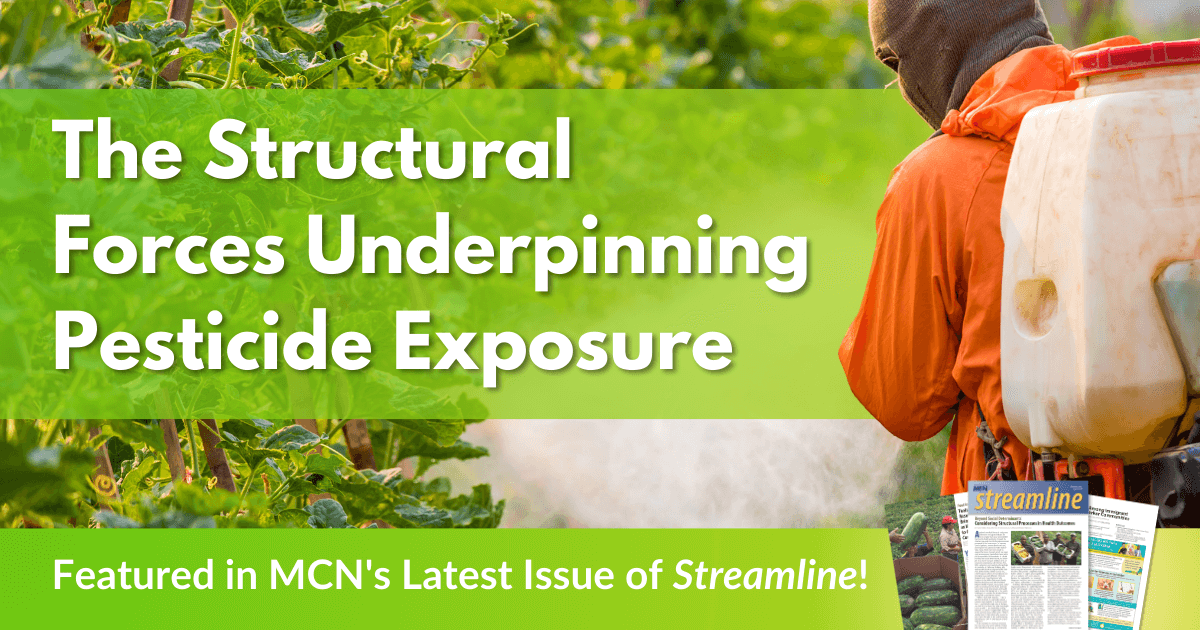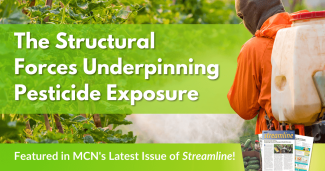New Article: The Structural Forces Underpinning Pesticide Exposure

[Editor’s Note: Clinicians across the country received the summer issue of Streamline in their mailboxes earlier this month. To celebrate the newest issue, we reprint this article on how structural injustices make pesticide exposures more dangerous for farmworkers than a general population. You can read more about structural competency for clinicians in the cover article of the same issue, “Beyond Social Determinants: Considering Structural Processes in Health Outcomes.” Read or download the entire summer issue on our Streamline page. Sign up for free to receive our in-print quarterly clinical publication here.]
Agricultural workers bear a disproportionate burden of pesticide exposure in the United States. While that pronouncement may seem obvious (as agricultural workers apply the chemicals, work in fields that have been sprayed by the chemicals and are exposed in other ways including by pesticide drift), numerous structural factors place agricultural workers at an increased risk of exposure, unnecessarily exposing them to chemicals when they should be protected and safe. In a new research article published by the Brookings Institution, a US-based think tank focused on social sciences, authors Nathan Donley, PhD and Robert Bullard, PhD outline how diet, housing, occupation, and institutional failings result in higher pesticide exposures for agricultural workers. Here, we briefly review each of these elements outlined by the article, and then expand the lens by taking a structural look at why each element may be contributing to pesticide exposure.
Diet
The consumption of organically grown food reduces one’s pesticide exposure, as the food itself is grown without synthetic pesticides. Organic food, however, is more expensive and less widely available than conventionally grown food. Agricultural workers live in rural communities, many of which are designated as “food deserts” with few outlets in which to purchase food, and even fewer that may stock specialty items like organic produce. With very limited income, or income that is designated for other needs including to send to their home communities, agricultural workers are unlikely to be able to afford organic food. Looking further into these access issues, rural areas continue to drop in population, simultaneously as the consolidation of grocery stores has reduced the number of outlets where the remaining rural residents can buy food. While Walmart, one of the few remaining grocery stores in many rural areas, has rapidly increased the amount of organic food available in its stores in the last 10 years, and aims to provide it at a lower price point, agricultural workers on average make just $20,000 per year,1 making even the least expensive staples sometimes out of reach. (See this issue’s article on food insecurity.)
The poverty wages that agricultural workers receive are rooted in an agricultural system that began with slavery and exploitation, note the authors of the article. “This history explains why 98% of US farmland is owned by whites and the vast majority of agricultural laborers are people of color,” they noted. While the race and ethnicity of most agricultural workers have transitioned from African American to primarily people from Mexico and Central America, the exploitative conditions and poverty wages remain largely unchanged, due to structural forces that demand low-cost fresh produce and devalue farmwork, and policies to support those demands. The Fair Labor Standards Act of 1938, for example, specifically excludes farmworkers from core labor rights including minimum wage and overtime, which still stands as federal policy to this day.
Housing
Workers often live close to farms in employer-provided housing where their risk of pesticide exposure is higher, due to proximity to pesticide application, inability to avoid exposure even indoors in substandard housing, and poor access to safe drinking water. Those who live off-farm still likely reside in agricultural communities with limited access to safe, quality housing. Redlining, the discriminatory practice of actions like denial of mortgages or other loans to people of color to prevent their access to certain areas; the use of eminent domain for economic development; and racially motivated zoning ordinances are outlined in the article as historical factors that reshaped neighborhoods, removing access for people of color to live in clean, safe neighborhoods and relegating them to less safe and healthy areas. Further, people of color are unable to “utilize monetary gains to change occupations or move away” from polluted areas. The authors were careful to note that the racial disparities are not solely a result of poverty. “Race and ethnicity remains [sic] a potent predictor for many pollution threats regardless of income level,” the authors concluded, adding the example: “African Americans who make $50,000-$60,000 a year tend to live in neighborhoods that are more polluted than neighborhoods inhabited by whites with annual incomes of less than $10,000.”
The manufacturing of pesticides also has structural considerations. Because of the housing practices outlined above, most pesticides are manufactured in low-income communities of color, and facilities in lower-income areas typically invest less in pollution reduction than in higher income areas. Structural considerations that resulted in this situation include the role of income and race in representation and personal connections, that lead to power imbalances and unfair policies.
Occupation and Institutional Failings
Pesticide exposure among agricultural workers could be reduced, but US occupational safety and health policy specifically excludes agricultural workers. “Agricultural exceptionalism” is evident in the regulatory norms for agricultural workers; agricultural workers are excluded from most of the protections afforded other workers through the Occupational Safety and Health Administration. Another example is the double standard created by the Food Quality Protection Act of 1996, in which the general population has more protection against pesticides through food and water than the workers who encounter the chemicals directly on the farm. Additionally, the article outlines numerous practices and loopholes that perpetuate inadequate pesticide regulation at the federal level.
Solutions
Solutions are readily available. Agricultural workers, as a vulnerable workforce in a high-hazard industry, require strong, consistent regulatory protections, equal to or greater than that of workers in other industries. The authors outline a structural approach to reducing pesticide exposure, outlining eight specific solutions: eliminating or reducing the pesticide safety double standard; implementing practices to better monitor and address real-world harms to impacted communities; strengthen worker protections; reduce harms from unintended pesticide use; adequately protect children; codify prior informed consent for the export of unregistered pesticides; protect communities near agrochemical production and storage facilities; and assess and rectify regulatory capture by industry with the EPA Pesticide Office.
While the article does not emphasize the role of clinicians in pesticide exposure, the clinical role in pesticide prevention and reporting is significant, in the absence of sufficient occupational safety and health protection, especially given the many vulnerabilities that agricultural workers face that may prevent them from understanding the risks of pesticides or having sufficient agency to report abuses. Clinicians need to be trained to recognize the signs and symptoms and to manage pesticide overexposure. Additionally, clinicians must screen their patients on their occupations. Accurate identification can lead to improved diagnostic decisions by the clinician. Clinicians are encouraged to incorporate three concise and effective screening questions in the primary care setting:
- Occupation: Describe what you do for work/Describa lo que hace en su trabajo.
- Activities and Causes: Are there any physical activities that you do – at work or away from work – that you feel are harmful to you?/ ¿Hay alguna actividad física – en su trabajo o en otra lugar – que crea usted es dañina para usted?
- Substances and Physical Hazards: Are you exposed to chemicals, fumes, dusts, noise, and/or high heat at your work or away from work? Do you think these are harming you?/¿Está usted expuesto a químicos, gases, polvo, ruido, y/o altas temperaturas en su trabajo o en otro lugar? ¿Piensa ustd que estas cosas lo pueden dañar?
Access a printout of these three questions in English and Spanish with graphics here: https://www.migrantclinician.org/toolsource/resource/eoh-screening-questions-primary-care.html
Tools and resources on Migrant Clinicians Network’s website include:
- Comic books: Full-color comic books in English and Spanish:
https://www.migrantclinician.org/pesticide-comic-books.html- Juan abre los ojos: Como protegerse de los pesticidas is a general comic book on pesticides for agricultural workers.
- Aunque cerca… Sano educates parents on the risk of pesticide exposure for children.
- Poco veneno… No mata covers the risks of pesticides and ways to minimize the risks in the home setting.
- Lo que bien empieza… Bien acaba addresses pesticide exposure in women of reproductive age.
- Nadie sabe que repira… ¡Hasta que le falta el aire! is our newest comic book on respiratory health. (See accompanying article for more on this resource.)
- Pesticide Exposure Reporting and Workers’ Compensation Map: Developed with Farmworker Justice, this map provides clinicians with state-specific pesticide reporting requirements as well as workers’ compensation criteria.
https://www.migrantclinician.org/pesticide-reporting-and-workers-compensation-agriculture-interactive-map.html
- Pesticide webpage: All of these resources are outlined on our Pesticides page, including additional resources on clinical guidelines on acute pesticide exposure, cholinesterase testing protocols, and more. https://www.migrantclinician.org/explore-environmental-justice-and-worker-health/pesticides.html
- Recognition and Management of Pesticide Poisonings 6th Edition: EPA’s essential clinical reference for recognizing and managing pesticide overexposures.
https://www.epa.gov/pesticide-worker-safety/recognition-and-management-pesticide-poisonings
The open source article is available in its entirety on the Brookings Institute website:https://www.brookings.edu/articles/us-pesticide-regulation-is-failing-the-hardest-hit-communities-its-time-to-fix-it/
Reference
1 US Department of Labor, Employment and Training Administration. Findings from the National Agricultural Workers Survey (NAWS) 2015-2019: A Demographic and Employment Profile of California Farmworkers (Research Report No. 15). Released 3 June 2022. Available at: https://www.dol.gov/agencies/eta/research/publications/findings-national-agricultural-workers-survey-naws-2015-2019
- Log in to post comments


